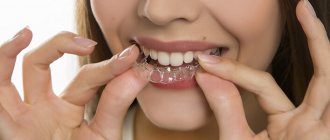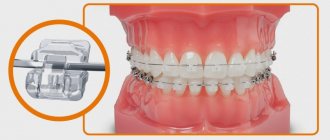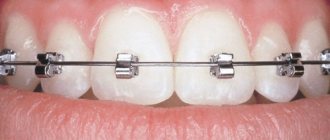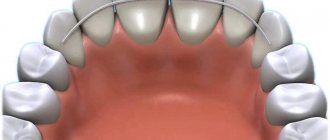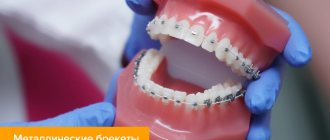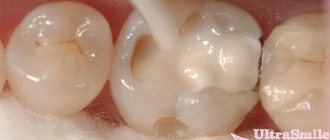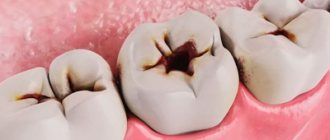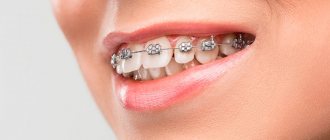10262
Not every person can be proud of healthy and straight teeth, so to correct their position, braces were created, thanks to which the most complex problems of malocclusion can be resolved.
In a short period of time, they have won the trust of not only orthodontists, but also the majority of grateful patients, and every year their design increasingly matches the quality and precision of innovative technologies.
Not everyone knows what braces are and how they work. Let's try to understand in detail the principle of their operation.
Content:
- Who is recommended for teeth straightening with braces?
- Preparing to align rows with braces
- Installation of braces
- Wearing braces during teeth straightening
- Removing the leveling device
- How long to wear braces
- When alignment with braces is not possible
How do braces straighten teeth? They do not do this by themselves, since in reality they play only a secondary role. After all, the term “braces” hides tiny locks that are responsible for holding the metal arch. It is the latter that does all the leveling work - moves the curved units and forces them to take the correct positions. But it just so happened that the entire orthodontic structure was named after the miniature locks.
Types of bracket systems by material
Before the advent of modern orthodontic systems and the ability to choose the material from which they are made, many people, even if they wanted to correct their dentition, avoided installing braces. This was explained by the unaesthetic appearance of the metal structure attached to the outside of the teeth.
Today, several types of braces have been developed and used in dental practice, the difference between which is in the material of manufacture and the method of fastening. Among the variety offered, there is always a suitable option.
Metal braces
Systems made from medical steel are the most “democratic” in price, accessible to many. This factor, plus the reliability and durability of the structure, make metal braces popular. However, not everyone is ready to resort to this option due to aesthetic considerations: the smile of the owner of such braces cannot be called attractive. If a charming smile is important to you even while wearing the system, then you should pay attention to other types.
Ceramic braces
Ceramics do not spoil the appearance of teeth, since such braces are almost invisible on the teeth. They are practically no different from tooth enamel, but over time, under the influence of certain drinks (coffee, tea, red wines) and coloring spices, they may become slightly stained. Also, ceramic braces are not sufficiently resistant to mechanical stress.
Plastic braces
The first orthodontic system to compete with metal braces. Aesthetically, plastic looks much better and is almost as invisible. However, there are also disadvantages: low strength, coloring under the influence of food and drink dyes. In this case, you can use colored braces, but this is a matter of taste.
Sapphire braces
The installation of sapphire braces has virtually no effect on your appearance - they are transparent and almost invisible. Made from aluminum oxide. The main and main disadvantage for the widespread use of sapphire systems is their high cost. But the advantages - attractiveness, absence of allergic reactions, high strength and comfort while wearing make this type of system quite popular.
Titanium braces
Absolutely safe biocompatible orthodontic structures. Robust, durable and reliable systems, recommended for allergy sufferers. A relative disadvantage is that they stand out on the surface of the teeth.
Combined braces
Today, this is a successful, popular option in many respects. The doctor can install different types of systems, depending on the situation. For example, if the lower row of teeth is more crooked, metal braces are installed on it, and a more attractive-looking structure is placed on the upper row. In this case, you can also put cheaper metal braces on the side teeth.
In general, you need to know that the appearance of braces does not affect the effectiveness of obtaining the final result. When choosing a system, you should focus on your financial capabilities, aesthetic requirements and individual needs. But in any case, the final choice of a corrective system is made after visiting an orthodontist and receiving a consultation from him.
Who is recommended for teeth straightening with braces?
The process of correcting malocclusion is long and complex. A couple of months cannot significantly affect bone tissue; you need to wear an orthodontic device for a year or more. Day after day, the arch will exert the required force on the dentition, as a result of which units that are out of place or at the wrong angle will begin to correct themselves.
Indications for wearing braces are:
- incorrectly formed bite;
- anomalies in the location of individual canines, incisors or molars;
- preparation for prosthetics;
- improving the aesthetics of a smile in the presence of dentofacial curvatures.
The doctor makes the decision to conduct orthodontic therapy after an in-person examination and preliminary diagnostics. It is important for the patient to listen to the dentist’s instructions. Then he will have a chance to make his smile beautiful and healthy in the coming years.
Operating principle
Once the orthodontist has installed the braces, the ligaments surrounding the tooth in the socket are subjected to force. To maintain the same usual balance, the body’s work is aimed at maintaining the volume of connecting fibers.
Therefore, in the area where sharp compression of the ligaments occurs, the bone tissue of the jaw begins a resorption process, which leads to the formation of additional interdental space for the movement of the bone organ.
In another area where the fibers have been stretched, new bone tissue begins to form, which serves as an obstacle to the tooth returning to its original pathological position.
The main advantage of braces is the fact that the result can be maintained for the entire life of the patient, which is why these orthodontic structures are recommended for installation at any age.
However, it is important to note that the correction process is delayed for a long period, and the tooth moves no more than 1 mm in 30 days.
Applying a lot of pressure cannot speed up the movement of teeth. If the force calculated by the orthodontist exerts a strong load, the nerve endings and tube-like blood formations surrounding the dental unit will be damaged, which will disrupt the blood circulation process.
The presence of these disorders complicates correction and reduces the speed of movement of bone organs. In addition, the patient will experience pain.
Dentists' opinions on lingual braces, their pros and cons, as well as the main differences.
In this article we will discuss up to what age you can get braces.
Follow the link https://orto-info.ru/sistemyi-vyiravnivaniya-zubov/breketyi/pochemu-otkleilsya-i-chto-delat.html, and find out what to do if the bracket on the last tooth has come off.
What moves teeth?
Many patients believe that the position of the tooth is corrected by braces, however, this opinion is erroneous. The entire correction process is set by an arch, which serves as a connecting link and brings the teeth together using brackets. It is the arch that will move the dental units in the desired direction.
In order for the bracket system to effectively cope with its task, the orthodontist periodically replaces the weakened arch with a tighter one.
The bracket is fixed using a special composite in the middle of the tooth surface. Each unit becomes the owner of an individual bracket.
For example, if you fix a bracket on an incisor, which is made for a molar, the dental unit will never take the correct position. Everything is explained by the presence of a special angle and inclination in the bracket, which are suitable for an individual dental unit.
In order for the dentition to change from a pathological appearance to a correct one, the orthodontist sets the arch a certain shape, which by its effect will guarantee the final result. During the treatment process, the wire arch tends to the initially given shape and, under the influence of force, slowly tightens the parts fixed on it (locks, rods).
At the initial stage of treatment, the specialist installs a thin elastic arch, the effect of which will be delicate displacement. This will allow the teeth to get used to the pressure and reduce the patient’s discomfort and pain.
The process of moving a tooth weakens the bone, which allows new bone to form to hold it in the corrected position.
Technically, this stage can be called bone remodeling. Remodeling of bone tissue occurs due to the loads acting on it.
The whole process consists of strengthening bone tissue during prolonged pressure and weakening it in the absence of force.
Bone tissue consists of cells that are medically called osteoclasts and osteoblasts. In orthodontics, experts distinguish two forms of bone atrophy:
- direct thinning of bone plates;
- degenerative decrease in height, width and density of bone tissue.
Depending on the form of atrophy and orthodontic mechanics in general, the effectiveness and speed of treatment will vary, and the list of possible reactions to bite correction with braces is quite diverse.
Watch a video about how braces are removed and find out whether the procedure hurts.
Read here about the features of Sprint Quick braces.
At this address https://orto-info.ru/sistemyi-vyiravnivaniya-zubov/breketyi/po-tipu-materiala/metallicheskie/pilot.html you will find reviews about Pilot braces.
Difference between ligature and non-ligature systems
Which braces system to choose - ligature or non-ligature?
It is immediately worth noting that the choice between a proven design, which has proven its effectiveness for decades, and a modern product developed using new technologies, puzzles everyone who has decided to correct a pathological bite.
To understand and make the right choice, consider the main differences between the systems:
- Method of fastening the arch (ligature - rods, non-ligature - micro-locks).
- Sizes (ligature ones are thin in thickness, non-ligature ones have a powerful size of brackets).
- The final result (ligature ones are able to correct the most complex pathologies, non-ligature ones cope with simple problems).
- Scheduled visits to the orthodontist (ligature systems require constant monitoring of the condition of the arches and rods, self-regulating braces do not require frequent visits to a specialist).
- Hygienic care (the presence of additional elements in ligature systems complicates the cleansing process).
- Cost (systems equipped with micro-locks are much more expensive than classic designs).
It is important to note that the correction process using ligature systems takes a longer period compared to self-regulating structures.
Preparing to align rows with braces
Before installing braces, the doctor makes sure that the gums and teeth are in satisfactory condition.
If there is caries, pulpitis, gingivitis or any other dental disease, it must be treated. After installing metal arches, it is much more difficult to combat the symptoms of oral diseases. Also during the preparatory stage:
- radiography;
- taking impressions of both jaws;
- articulator examination.
Considering that each clinical case is unique, the patient may be prescribed consultations with a surgeon, orthopedist, or implantologist.
Stages of treatment with braces
Correcting a bite with braces takes place in several stages:
- Preparation for orthodontic treatment - obtaining x-rays, OPTG, TRG and others. The doctor will also refer you for treatment of caries and pulpitis if he diagnoses signs of dental problems. Additionally, professional teeth cleaning and, in rare cases, removal of individual teeth are indicated.
- Fixation of the bracket system. The doctor will attach the plates under the arch on the patient’s teeth and install a wire of a suitable diameter and shape. During the treatment process, the orthodontist will gradually increase the diameter of the arches, and at the final stage, use a rigid rectangular wire.
- Removal of braces and retention period. The last stage is necessary to secure the position of the teeth in the correct positions. To do this, the patient is given a non-removable retainer on the sublingual side or night guards are prescribed.
The duration of treatment with braces depends on many factors - the complexity of the pathology being corrected, the anatomical characteristics of the patient, and the selected brace material.
Installation of braces
When the patient's oral cavity is prepared for orthopedic therapy, he is invited to an appointment. Most often, retaining clasps are fixed in a direct way, that is, they are glued separately to each unit. But with the advent of modern dental technologies, doctors can also use an indirect fixation method - through mouth guards.
The standard procedure takes about one and a half hours and is carried out according to the following scheme:
- removing tartar using an ultrasonic scaler;
- washing and drying crowns;
- application of primer and adhesive;
- alternate gluing of locks;
- removing excess adhesive from the surface of dental crowns;
- light polymerization.
When gluing locks, it is important to leave just enough adhesive on the enamel as needed. If there is too much of it, it will come out from under the metal bases and will become colored with food coloring over time. Then the space surrounding the castles will become gray and spoil your smile.
If you remove too much of the cured compound, large gaps will form between the braces and the enamel. Food will begin to accumulate in them, and pathogenic microorganisms will begin to multiply. And this is a direct path to caries and related complications.
How do ligature braces correct a bite?
In classic designs, the arch is fixed with ligatures - thin wires or miniature rubber bands that cling to the wings of the brackets. When the time comes to replace the arch, the doctor removes all the ligatures, changes the wire and puts them on again.
As a rule, ligature braces are cheaper than non-ligature braces, which we will talk about later. They are often recommended for teenagers because they are budget-friendly, and colored elastic bands can become part of the image.
Disadvantages of the ligature system:
- It takes a lot of time to install and activate;
- The arc puts a lot of pressure on the teeth because it is pressed very tightly to the bottom of the groove;
- A lot of plaque accumulates between the ligature and the enamel, which is difficult to remove, therefore increasing the risk of developing caries.
To eliminate design flaws, orthodontists have developed a new solution - non-ligature (self-ligating) models.
Wearing braces during teeth straightening
After installing braces, the patient must come for consultations at intervals specified by the doctor. During them, the doctor will analyze the changes and change the degree of pressure of the arc on the dentition. At first the mechanism puts little pressure on the rows, but gradually it becomes more and more rigid. This is necessary for the teeth to finally take the correct positions.
When using a brace device, the patient should adhere to the following rules:
- Do not create temperature changes in the oral cavity, do not eat too hot or very cold foods. This also applies to drinks. If you ignore this recommendation, the locks may peel off from the enamel. Also, deformation of the metal arc cannot be ruled out, which is unacceptable, since it will “drag” curved units with it.
- Forget about chewing gum. It happens that they stick to the elements of the system, then cleaning them is very problematic.
- Do not eat crackers or seeds. They are stuffed under the parts of the orthodontic structure. It's difficult to get them out. If you do not pay attention to their accumulation, the risk of caries will increase.
- Do not chew hard foods (nuts, crackers, hard vegetables), as the apparatus may break while chewing them. It is unlikely to be repaired, which means that you will have to start the alignment procedure from the very beginning.
- Maintain good oral hygiene. Pay special attention to the condition of the enamel and gums. When cleaning hard-to-reach places, use not only a brush, but also floss and irrigator. After each meal you should rinse your mouth with warm water.
If any questions arise while straightening teeth with braces, the patient should immediately contact an orthodontist. The doctor will advise and give practical recommendations.
Design
The bracket system always consists of two main parts:
- special arc;
- brackets or brackets (locks) that are fixed to the surface of the dental unit.
The clasps are attached to the inner or outer surface of the bony organ of the oral cavity using a special adhesive.
Next, a special metal arch is inserted into the groove of the brackets, which is held in it with the help of rods (elastic bands, ligatures). Their fixation is performed on the wings of the bracket.
If the system is ligature-free, the device operates without rubber bands, and the effectiveness of the correction is ensured by a special design.
Modern braces have greatly improved. They not only have a miniature size, but are also made from various materials:
- metal;
- plastic;
- ceramics;
- sapphire.
Metal braces have become very popular. The following metal alloys are used for the manufacture of brackets and special arches:
- steel;
- titanium;
- Nickel
Ceramic and plastic systems have a perfect aesthetic appearance, are durable and safe, however, they are expensive, which makes them less affordable for most patients.
In addition to the main elements, the bracket system can be equipped with orthodontic rings with a soldered locking part, which are attached to the last chewing units, and sometimes to the wisdom tooth.
The presence of these elements is appropriate when it is not possible to secure the bracket (large filled area at the attachment site, artificial tooth).
Before installing the rings, the orthodontist fixes the separators, which will temporarily ensure the separation of the bone organs for several days.
Another important additional element of the braces system is the elastic chain. Its action is to contract, which brings the braces closer along the arc, which means it reduces the distance between the teeth.
In addition to all the listed elements, during orthodontic treatment with braces, specialists use the following parts:
- metal springs;
- buttons;
- metal ligatures;
- metal bands for a group of dental units;
- special tubes for the arc made of silicone;
- turbobytes;
- bite fillings.
Removing the leveling device
When day “x” arrives, the patient can’t wait to see his new beautiful smile.
But you won’t be able to enjoy her appearance for long. The fact is that after removing the braces you will have to wear retainers for some time. These are thin wires that prevent a healthy bite from becoming abnormal again. Afterwards, you may need to use a mouth guard. Only when the risk of the curvature returning disappears will the doctor allow you to permanently abandon all corrective mechanisms.
Advantages and disadvantages of ligature systems
The operating principle of this type of braces makes it possible to achieve high efficiency in the correction process. However, their pros and cons should be considered. Here are the advantages of ligature bracket systems:
- Good results in bite correction.
- A wide range of pathologies that they can correct.
- Possibility to diversify the external design by changing the color of ligatures and locks.
- Budget cost.
The ligature system also has its own features:
- Frequent visits to the orthodontist to replace ligatures.
- Elements that are too hard may cause discomfort when worn.
- Light-colored rubber ligatures may become stained from contact with food.
Despite these disadvantages, ligature braces are used much more often to correct dental pathologies.
How long to wear braces
Straightening teeth is a very painstaking process. Regardless of the type and material of the leveling structure, it will have to be worn for 1-1.5 years. In some cases, the duration of treatment is 2 years. If we take into account the need for subsequent use of retainers and mouth guards, the time period will increase even more.
No need to be upset. The jaws quickly get used to the metal arches, and therefore after just a few weeks of using them, a person practically stops noticing them. It is much wiser to spend one or two years on orthodontic therapy than to suffer for the rest of your life due to an incorrect bite.
addictive
Unfortunately, you cannot do without an adaptation stage during treatment with braces. Based on the fact that their action consists of mechanical force, the intensity of the discomfort is unknown.
The process of addiction occurs differently for each patient. Adaptation depends entirely on the patient’s desire to correct the bite and the willingness to endure the discomfort.
After wearing the structure for some time, the patient and oral organs get used to the product, and it ceases to cause discomfort.
You can visually evaluate the process of braces in the video.
When alignment with braces is not possible
You cannot straighten your teeth using braces if:
- Full or partial edentia. There will simply be nothing to consolidate the basics on.
- Acute mental disorders. A mentally ill person may want to remove the device themselves and cause harm to themselves.
- Diabetes mellitus, severe diseases of the immune and endocrine systems. With these pathologies, the condition of blood vessels and bone tissue worsens. If the tissue becomes inflamed after braces are installed, the tooth may become loose and fall out.
It is also not recommended to install braces if you have bleeding disorders, HIV infection, sexually transmitted diseases, tuberculosis, or oncology. Treatment of malocclusions using braces requires a responsible and competent approach. Therefore, it is very important to entrust the therapy to an experienced and highly qualified doctor.
Types of braces based on location on teeth
In addition to the materials used, bracket systems are classified according to the type of their installation: vestibular and lingual. The first ones are easier to install and are attached to the outside of the teeth, the second - to the inside. Lingual ones are more difficult to install and adaptation to them takes longer, but they are not visible from the outside.
Vestibular braces (external)
Braces located on the visible outer part of the tooth are called vestibular. This type of braces is the most popular among patients. A variety of materials are used to make external braces - metal, ceramic, composite and aluminum oxide. When using this type of braces, there is no negative effect on the teeth. A special orthodontic material is used to attach the structure to the surface of the teeth.
Lingual braces (internal)
For many patients, the aesthetic side of the issue is of great importance: they are interested in installing the system in such a way that it is not visible. The problem is solved by using lingual (internal) braces; they are fixed on the inside of the teeth and those around them cannot see them. If we talk about an aesthetic solution, then this is the best option.
However, there are some inconveniences for the patient when wearing standard internal systems: it is not easy to adapt to them, plus diction suffers.
What else you need to know about how braces correct your bite
When a person wears braces, teeth move due to mechanical rather than physiological forces. The facial and jaw muscles are not involved in the restructuring, and in order for the displacement to be the least traumatic, without damaging the periodontium, root and pulp, it is necessary to correctly calculate which part of the tooth to press on.
The doctor makes the calculations manually. He is guided by standards that indicate the distance from the center of the bracket to the side, top and bottom edges of the crown. The orthodontist measures the required millimeters and finds the point of support and application of force. If these areas are incorrectly identified, the treatment outcome will be unpredictable and the displacement will be painful for the patient.
In order for bite correction to be effective and pain-free, it is important not only to select a brace system suitable for a specific pathology, but also to install it correctly. Half of the success of the correction depends on the experience of the orthodontist, so choose a specialist taking into account the reviews and reputation of the clinic.
It is important to change the arc on time
At each stage of treatment you need to get a certain result. Once it is reached and the teeth have assumed their new position, the archwire no longer works. And if you often postpone doctor's appointments, each week of delay prolongs the entire treatment.
Wearing one archwire for too long does not harm your teeth, but it does not make sense.
Treatment by an orthodontist requires self-discipline. Be prepared to adjust your schedule around your doctor's appointments. And remember that all this is done for the sake of health and a beautiful smile. And this is the best incentive!
Band arc and the appearance of a vertical groove
In his next apparatus, Engle replaced each vertical tube with a rectangular slot. The ribbon arc was also made from a gold alloy, but had a rectangular configuration measuring 0.036" (height) x 0.022" (width). The arc was installed in the grooves and fixed with pins. The main weakness of this device was that the groove of this size in this device provided relatively poor control of root position. The elasticity of the tape archwire simply did not allow for the torques needed to create root torque.
